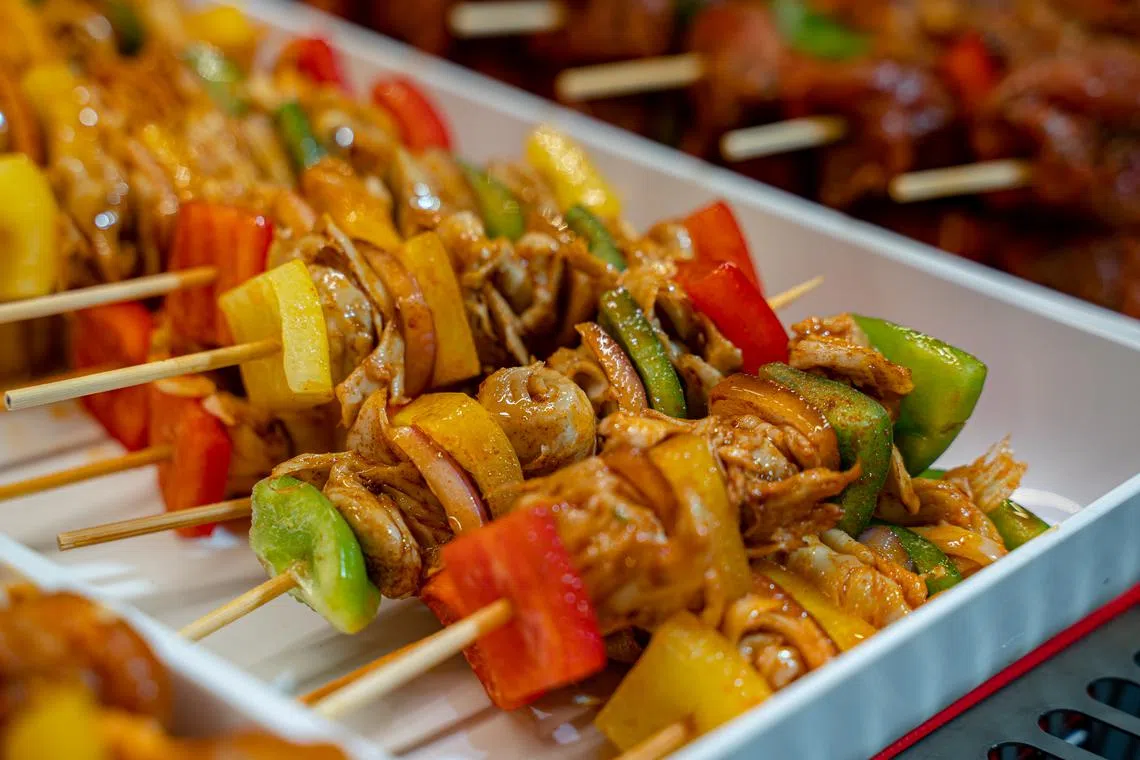UN report on safety of lab-grown meats cites S’pore, the only country selling them, as case study
Sign up now: Get ST's newsletters delivered to your inbox

Cell-cultured chicken kebab skewers can be bought at Huber’s Butchery in Dempsey.
PHOTO: GOOD MEAT
Follow topic:
SINGAPORE - Singapore is the only country in the world where consumers can buy cell-cultured chicken,
Two United Nations (UN) agencies released a global report to address this issue, in efforts to bring more of such foods to the dining table and assure consumers that they are safe to eat.
Traces of antibiotics in the meat product, pathogens in the animal cells that can spread to humans and possible genetic changes in cells as they multiply were identified as some of the potential hazards of cell-based meats in the report.
Put together by the Food and Agriculture Organisation (FAO) and the World Health Organisation (WHO), the report cited Singapore, which approved cell-cultured chicken for sale in 2020, as a case study in the regulation of such meats.
The report concluded that many of the hazards identified in cell-based foods already exist in conventionally produced foods and livestock agriculture, and hence the meats are safe for consumption if produced and handled well.
Released on Wednesday, the report was largely a result of a meeting among experts and officials from 15 countries and the two UN agencies in November 2022. The four-day meeting in Singapore was convened to identify the potential hazards that cell-cultured meat could harbour and ways to avoid them.
In Singapore, cell-cultured chicken by Californian start-up Eat Just was approved for sale three years ago. It is currently being sold at Huber’s Butchery
Other cell-cultured meats, such as beef and fish, are still being developed, while some firms abroad are seeking approval from the Singapore Food Agency (SFA) to sell their slaughter-free thin-cut steaks and minced pork items here.
Currently, there are more than 100 cell-based food start-ups around the world.
Cell-based meat is made by taking cells from a cow, chicken or fish through a biopsy and then growing the cells in a nutrient broth and media. The tissues are harvested, prepared and packaged into meat products.
Such meats generated from cells may combine different cell types like muscle and fat cells to replicate the structure and texture of meat. Extrusion techniques and 3D printing, as well as flavouring and preservatives, are used to create products that are close to meat from livestock.
Titled Food Safety Aspects of Cell-based Food, the report listed a number of possible hazards that could arise in each stage of the production process, from sourcing the cells to formulating the final nugget or steak.
The spread of foodborne pathogens such as Salmonella, E. coli and Listeria from the biopsied cells to the end product was one of the hazards highlighted in the report. But it noted that the risk was much lower when compared with livestock breeding.
To avoid this problem, cell-cultured meat firms can ask for livestock and aquaculture health certifications and inspection of the source animals to ensure they are disease-free. Testing for pathogens can also be done before banking the cells, said the report.
The use of antibiotics to prevent the cells from being contaminated by bacteria was also identified as an issue as residual antibiotics in the meat products could be a health hazard and contribute to antimicrobial resistance.
The report recommended that limited amounts of antibiotics should be used. Washing can help remove or reduce the concentration of contaminants in the final product.
Mutations from changes to the genes as the cells multiply could build up and create novel toxins.
However, the mutations alone will not pose any significant problems to consumers, said Professor William Chen, director of Nanyang Technological University’s Food Science and Technology programme.
“DNA from meat, with or without mutations, will be degraded in our digestive system, and thus they have a low possibility of integrating into our genes and leading to any potential health risks,” said Prof Chen. He is the vice-chair of the panel of international experts who gathered in Singapore in November.
Those allergic to seafood are likely to have the same reactions from eating cell-based shrimp or shellfish, and scientific research can help to alleviate this.
Prof Andreas Lopata from James Cook University in Singapore is currently analysing and comparing the tissues of different fish species to find out how much allergens they carry.
The aim is to find species with low amounts of allergens and use them to make safer cell-based fish fillets or sashimi.
The 146-page report included a case study on Singapore’s novel food scene and the SFA’s rigorous regulatory framework for novel foods.
The agency, a co-host of the November meeting with FAO, works closely with novel food firms to discuss safety assessment plans, and has also been offering virtual consultations for companies since 2021.
A key aim of the global report is to equip the authorities, particularly in less-developed countries, with knowledge about cell-based food production and help them shape their regulatory framework.
The document also noted that cell-based meats are an “alleged sustainable alternative” to conventional livestock, and more work is needed to prove that such meats are indeed greener.
The report concluded that hazard identification is only the first step of the formal risk assessment process for cell-based food, and more scientific data, insights and the sharing of information are needed to further the safety and trust in these future foods.
Prof Chen, who is also a consultant to FAO on alternative and novel foods, said: “The report would help cell-based meat companies align themselves with the global standard and harmonise their processes. This in turn would enhance food safety and boost consumer confidence.”


